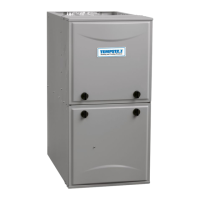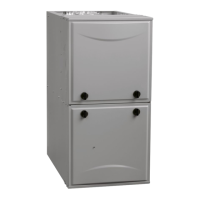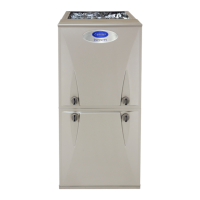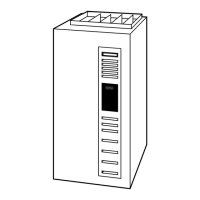F80CTL and G80CTL: Installation, Start–Up, Operating and Service and Maintenance Instructions
Manufacturer reserves the right to change, at any time, specifications and designs without notice and without obligations.
32
NOT forget to return setup switch to OFF position and remove jumper
upon completion of testing.
c. This furnace is capable of automatically providing proper airflow
to maintain the temperature rise within the range specified on
furnace rating plate. If temperature rise is outside this range,
proceed as follows:
(1.) Check gas input for low- and high-heat operation.
(2.) Check derate for altitude if applicable.
(3.) Check all return and supply ducts for excessive restrictions
causing static pressure greater than 0.5-In. W.C.
(4.) Ensure setup switch SW1-4 (Comfort/Efficiency) is in
OFF=Efficiency position when a bypass humidifier is used,
see Fig. 32 for switch location.)
(5.) Make sure proper model plug is installed.
d. Remove thermostat jumpers and release blower access door
switch.
e. Repeat Steps a through c as required to adjust for high heat
temperature rise.
f. When correct high heat input rate and temperature rise is
achieved, turn gas valve ON/OFF switch to OFF.
g. Release blower access door switch.
h. Remove manometer or similar device from gas valve.
i. Re-install manifold pressure tap plug in gas valve, see Fig. 21.
j. Remove thermostat jumper wire from furnace control board.
k. Turn gas valve ON/OFF switch to ON.
l. Proceed to Step 7, “Set Blower Off Delay” before installing
blower access door.
7. Set Blower Off Delay
a. Remove blower access door if installed.
b. Turn Dip switch SW-7 or SW-8 ON or OFF for desired blower
off delay, see Table 12, Table 14, Fig. 32, and Fig. 53.
8. Set thermostat heat anticipator.
a. Mechanical thermostat. Set thermostat heat anticipator to match
the amp. draw of the electrical components in the R-W/W1
circuit. Accurate amp. draw readings can be obtained at the wires
normally connected to thermostat subbase terminals, R and W.
The thermostat anticipator should NOT be in the circuit while
measuring current.
(1.) Set SW1-2 switch on furnace control board to ON.
(2.) Remove thermostat from subbase or from wall.
(3.) Connect an amp. meter across the R and W subbase
terminals or R and W wires at wall, see Fig. 48.
(4.) Record amp. draw across terminals when furnace is in low
heat and after blower starts.
(5.) Set heat anticipator on thermostat per thermostat
instructions and install on subbase or wall.
(6.) Turn SW1-2 switch OFF.
(7.) Install blower access door.
b. Electronic thermostat: Set cycle rate for 3 cycles per hr.
9. Set Airflow for Air Conditioning -Single Stage and High Stage
Cooling
The ECM blower can be adjusted for a range of airflow for Low
Speed or High Speed cooling. See Table 4-Air Delivery - CFM
(With Filter). Depending on the model size, the cooling airflow can
be adjusted from 1.5 to 6 tons based on 350 CFM/ton. Refer to
Table 13.
The cooling airflow is adjusted by turning Setup switches SW2-1,
SW2-2 and SW2-3 either ON or OFF. Select the required airflow,
see Fig. 14. Fig. 14 is based on 350 CFM per ton. For airflow at 400
CFM per ton, turn Setup SW1-5 ON, see Table 12, Table 14,
Fig. 32, and Fig. 53.
A96316
Fig. 48 – Amp. Draw Check with Ammeter
NOTE: 5.5 ton airflow will truncate at 2200 cfm on applicable models.
For a complete explanation of cooling airflow, refer to the section titled
“Sequence of Operation.”
Set Airflow For Continuous Fan/Low Speed Cooling Airflow The ECM
blower motor can be adjusted for continuous fan speeds different than
heating or cooling fan speed. See Table 4 - Air Delivery - CFM (With
Filter). Select the required continuous fan airflow, see Fig. 14.
The continuous fan speed is also the switch setting for low speed cooling
when furnace is used with a 2-speed cooling unit. Adjust the Continuous
Fan CFM to match the airflow required for low speed cooling. Select the
required airflow, see Fig. 50. For airflow at 400 CFM per ton, turn Setup
SW1-5 ON, see Fig. 14. The airflow selected for low speed cooling will
also be the airflow used for continuous fan.
Check Safety Controls
The flame sensor, gas valve, and pressure switch were all checked in the
Start-up procedure section as part of normal operation.
1. Check Main Limit Switch
This control shuts off combustion system and energizes
air-circulating blower motor, if furnace overheats. By using this
WARNING
!
FIRE HAZARD
Failure to follow this warning could result in personal injury, death,
and/or property damage.
Reinstall manifold pressure tap plug in gas valve to prevent gas leak.
CAUTION
!
FURNACE OVERHEATING HAZARD
Failure to follow this caution may result in reduced furnace life.
Recheck temperature rise. It must be within limits specified on the
rating plate. Recommended operation is at the mid-point of rise range
or slightly above.
Table 12 – Blower Off Delay Setup Switch
DESIRED HEATING MODE
BLOWER OFF DELAY (SEC.)
SETUP SWITCH
(SW-7 AND -8)
POSITION
SW1-7 SW1-8
90 OFF OFF
120 ON OFF
150 OFF ON
180 ON ON
R Y W G
10 TURNS
THERMOSTAT SUBBASE
TERMINALS WITH
THERMOSTAT REMOVED
(ANITICIPATOR, CLOCK, ETC.,
MUST BE OUT OF CIRCUIT.)
HOOK-AROUND
AMMETER
EXAMPLE:
5.0 AMPS ON AMMETER
10 TURNS AROUND JAWS
=
0.5 AMPS FOR THERMOSTAT
ANTICIPATOR SETTING
FROM UNIT 24-V
CONTROL TERMINALS
